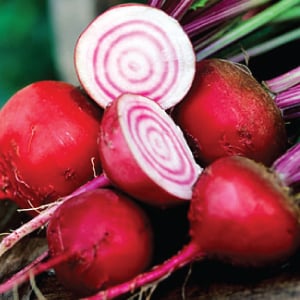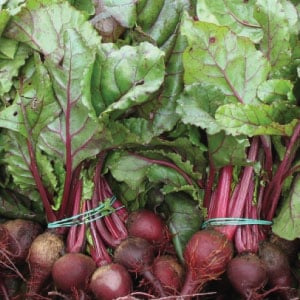
Learning Download: How to Grow Beets
From Seed to Harvest: A beginner’s guide to growing beets.
Beets are a unique root vegetable edible for both its bulb and green tops. The vegetable is a biennial, which means they flower and seed in their second year of growth, but beets are typically grown as an annual. This vegetable’s growing seasons are early spring to early to early summer or late summer to late fall, as it prefers cooler weather. Beets come in a popular red hue, as well as gold, striped and white varieties.
To plant:
Plant beet seeds in rows, with rows spaced 1 to 1.5 feet apart. Thin seedlings to 2 inches apart. Plant the seeds a half-inch deep and 1 to 2 inches apart. For an early crop, plant seeds in March. For the fall crop, plant seeds from June to September. Beets do not grow well in clay soils. To provide continuous beet harvest, plant the seeds in various locations with a three-week time difference.
To grow:
Beets should sprout 7 to 14 days after planting. Add an organic mulch of grass clippings or shredded leaves around the beets. Since beets consist of mostly water, the plant requires adequate watering to grow. Water beets at least an inch weekly if rain doesn’t supply enough moisture. Water slowly to permeate the soil and reach the root. Apply some high-nitrogen fertilizer six weeks after planting.
To harvest:
Beets are ready to harvest when their roots are the size of a golf ball, typically 50 to 70 days after planting. Harvesting times depends on the gardener’s preference, but larger bulbs will have a tougher texture. Clip the tops off the beets and enjoy the greens, as well. The greens hold more nutrients than the bulb. Beet greens are best harvested when the beet root is still young. When harvesting the bulb, leave some stem on the roots to avoid bleeding. Harvest the root by digging or pulling the plant from the ground.
What beets crave:
Beets crave full sun and loose, moist soil to produce the best crop. Beets grow best in soil with a pH of 6.0 to 7.0. Though beets can grow in partial shade, their roots may run into tree roots, so plant in deep soil.
Where to buy beet seeds:
You can find a wide variety of different colored beet seeds at Urban Farmer.
Learning Download: Common pests and diseases: Beets
Common pests and diseases: Beets
When growing vegetables, it is always exciting to care for the plant throughout its growing phase and then harvest it for delicious recipes later on, but one thing to watch out for is pests and diseases. Different plants are susceptible to different types of pests and diseases, and it is important to make yourself aware so you can keep a watchful eye and also take any preventative methods to keep your plants safe throughout their lifespan.
Beets can fall victim to several different pests and diseases.
Pests:
One of the pests that affects beets is the beet cyst nematode. Symptoms vary depending on when the beet is affected. if a seedling is infected, it will show stunted growth and less leaf growth. Older plants do not show as many symptoms. Below the soil, the roots will look stunted and exhibit lots of secondary roots. To prevent nematodes, weed the area around the beets well, and plow deeply in the summer.
Darkling beetles are a pest that will feed on the beet’s stem’s which will then show damage. This can cause seedlings to die. These beetles are typically most active during the night and will hide during the day. To prevent these beetles, remove the weeds from the field’s borders and apply the correct insecticides, which will typically be in the form of baits.
Leafminers are a pest that will leave white spots on the leaves, and this can result in the leaves dropping off the plant. To help prevent these, remove the plants from the soil immediately after you harvest them.
Diseases:
One common disease affecting beets is bacterial blight. When beets are infected with this disease, the leaves will show irregular-shaped spots with dark centers and black borders.Sometimes, the edges of the leaves may appear water-soaked. Later, the leaves may appear water-soaked. Later, the leaves will turn yellow and necrotic. The spots can even grow and join together and cause the leaf to dry and then fall off the plant. The bacteria is spread usually by rainfall or by insect injuries. This disease can also affect beans, eggplants, lettuce and peppers. The best way to manage this disease is by ensuring your seeds are disease-free.
Another common disease is called scab, and this causes round spots on roots that grow and turn brown and then rupture the epidermis. This disease is more common among dry conditions, and the best way to prevent this disease is to avoid planting in soil that is infected and also avoid rotating beets in the same area as potatoes.
Beet wester yellow virus also affects beets. Its symptoms are older leaves will begin to show yellowing, and then possibly show small reddish-brown spots. Leaves will then grow thick, leather-like and brittle. This virus is transmitted by aphids, so be sure to control any aphid problems near your beets.


